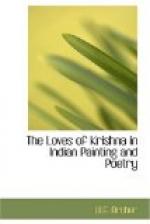of this part of India. Hymns to Krishna were
sung in the villages and as part of this fervid adhesion,
local manuscripts of the
Bhagavata Purana and
the
Gita Govinda were often produced.
Such manuscripts were normally not illustrated but
were preserved between wooden covers, on which scenes
of Krishna dancing with the cowgirls or with male
devotees were painted.[123] Book covers of this kind
were produced in the seventeenth and eighteenth centuries
and the resulting pictures have something of the savage
elation associated with the Basohli style and its
derivatives. During the nineteenth century, painted
book-covers ceased to be produced but three other
kinds of painting continued to celebrate the Krishna
theme. Frescoes of Hindu gods and goddesses including
Krishna were often executed on the mud walls of village
houses in Mithila, the birthplace of the poet Vidyapati,
and the style of painting with its brilliant colours
and brusque distortions testified to the great excitement
still engendered by Krishna’s name.[124] At
Kalighat near Calcutta, a special type of water-colour
picture was mass-produced for sale to pilgrims and
although the stock subjects included almost every
Hindu god, many incidents from Krishna’s life
were boldly portrayed.[125] The style with its curving
sumptuous forms is more a clue to general Bengali interests
than to any special attitudes to Krishna, but the
pictures, strangely parallel in style to the work
of the modern artist Fernand Leger, have a robust gaiety
and bounding vigour, not inappropriate to the Krishna
theme. The third type of painting is the work
of professional village minstrels known as
jadupatuas.
As a means of livelihood,
jadupatuas travel
from village to village in West Bengal, entertaining
the people by singing ballads and illustrating their
songs with long painted scrolls. As each ballad
proceeds, the scroll is slowly unwound, one scene leading
to another until the whole is concluded. Among
the ballads thus intoned, the romance of Krishna is
among the most common and the style of painting with
its crude exuberance suggests the strength of popular
devotion.[126]
There remains one last form of painting. During
the twentieth century, the modern movement in Indian
art has produced at least four major artists—Rabindranath
Tagore, Amrita Sher-Gil, Jamini Roy and George Keyt.
Of these four, the first two did not illustrate the
Krishna theme. Jamini Roy, on the other hand,
has often painted Krishna as flute-player and dancer.[127]
It would be unrealistic to suggest that these pictures
spring from a lively sense of Krishna as God—Jamini
Roy has, in fact, resorted to themes of Christ with
equal, if not greater, frequency but has shown no
signs of becoming a Christian. It is rather that
in painting these pictures, he has treated Krishna
as a symbol of rural vitality, a figure whose boisterous
career among the cowherds is an exact reflection of
his own attitudes and enthusiasms. To Jamini
Roy, the Bengali village with its sense of rude health
is infinitely to be preferred to a city such as Calcutta
with its artificiality and disease and in a style of
bold simplifications, he has constantly celebrated
the natural vigour and inherent dignity of simple
unsophisticated men.




